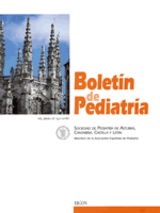La consulta telefónica: Utilización y posibilidades en atención primaria
S. Alberola López , Mª del Real Llorente , R. Ortega García , B. Maestro González , J. Andrés de Llano
Bol. Pediatr. 1997; 37 (162): 221 - 225
Objetivo: Analizar las consultas telefónicas (CT) recibidas en un Centro de Salud, para conocer sus motivos y su utilidad. Pacientes y metodos: Se realiza un estudio prospectivo de casos y controles híbrido. Se recoge cada llamada realizada a la consulta de Pediatría de un Centro de Salud urbano durante febrero y marzo de 1997. Las variables analizadas son: edad, sexo, motivo de la consulta y comportamiento ante la llamada. Se compara con el grupo control en consultabilidad e ingresos hospitalarios en el último año. Se realiza estadística descriptiva e inferencial, utilizándose pruebas paramétricas y no paramétricas. Resultados: Se han recibido 165 CT (media: 4,2 ± 1,9 DS CT/día), que representan un 6,6% de los pacientes atendidos en consulta. Se resumen los datos más relevantes: La edad media de los pacientes es 53 ± 52 meses y no hay diferencias entre sexos. El 33% consulta por síntomas, el 23% por cuestiones administrativas y el 4.8% requiere atención domiciliaria. Un 72% de las CT se resuelve mediante información/citación, y en un 17% es requerida por el pediatra el traslado de los niños a la consulta. Solo se encuentran diferencias (p=0,0001) entre los casos y los controles en el número de consultas a demanda. Conclusiones: 1.- La CT no supone una sobrecarga asistencial importante pero resuelve adecuadamente la mayoría de las cuestiones planteadas. 2.- La CT es útil para facilitar asuntos administrativos y temas técnicos y clínicos pendientes de resolver. 3.- La CT es más utilizada por los pacientes de mayor frecuentación en el Centro de Salud. Abstract Objectives: To analyze the telephones encounters (TE) received in a Primary Care Office to know their causes and their usefulness. Patients and methods: A hybrid case-control prospective study is done. Every telephone call achieved to a urban pediatric primary care office in February and March 1997 are registered. The variables studied are: age, sex, cause of the TE and behavior due to the call. The patients who do TE are compares with a control group about visits to the office and hospital admissions in the last year. Descriptive and inferencial statistic studies are developed using parametric and non-parametric tests. Results: 165 TE (mean: 4.2 ± 1.9 DS TE/day) have been received meaning 6.6% of the patiens who attend the office. The most outstanding facts are summarized: the mean age of the patiens is 53 ± 52 months and there are not differences between sexes; 33% of patients consult about symptoms, 23% of them about administrative questions and 4.8% of them request home care; 72% of TE are sold by information or giving an appointment, and in 17% of TE the attendance of the children to the office is required by the pediatrician; differences have been founded (p=0.0001) between cases and controls only about visits to the office (face to face visits). Conclusions: TE are not an important asistential burden by they resolve most of the raised questions promptly. TE are useful to make easier administrative items and technical and clinical topics remained to solve. TE are more used by the patients who attend more frequently to the office in Primary Care Center.
\N
\N
Artículo completo (PDF) (23 kb.)
- Otros
